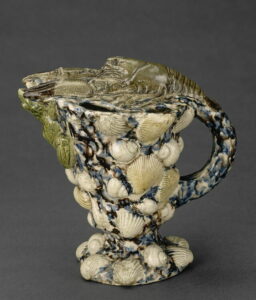Votre panier est actuellement vide !
Pottery is an alchemy
Pottery is the art of creating objects with your hands. The beginner stops here, before discovering all the ins and outs of this craft. More than a manual practice, this technique is really an art of living, and we can consider that pottery is an alchemy.
Alchemy is an occult science from the Middle Ages, based on the search for the transmutation of metals into gold. A whole life would not be enough to know alchemy in depth, it is a very vast field. Many parallels can be made between pottery and alchemy : let’s discuss them together !
NB : Far from being an expert in this field, I would like to stress that what is presented here is a set of metaphors, not an a posteriori explanation of the past by the future. I don’t know if pottery and alchemy are historically linked, they are just parallels !
~ The basic principle: transforming worthless material into gold ~
One of the fundamental researches in alchemy is to transmute base metals into pure gold (transformation called chrysopoeia) or silver. Most alchemists did not aim to find an unlimited source of money, but rather wanted to satisfy their passion and knowledge of the natural elements. The raw materials used are very diverse, and their scarcity increases as the transformation proceeds. The potter is thus an alchemist in the sense that he transforms mud into a work of art. He can see beyond the mud and sees it as a potential masterpiece ! They also have speculation in common : for example, making new glazes requires imagining how changing a recipe would change the color, without being able to see the effect immediately.
Colors have an importance in alchemy, and the accomplishment of the Great Work (realization of the Philosopher’s Stone) goes through three phases. The first phase is the extraction of the underground clay : this is a repulsive stage because it is dirty and the extracted earth is full of impurities. The sifting of this earth, the kneading, the passage to the plodder is similar to the work in white : the earth undergoes a purification, a washing of impurities and air bubbles. Finally, the red work takes place in the athanor, the pottery kiln : the final transformations take place there in the greatest secrecy.

Alchemy distinguishes 3 principles (Mercury, Sulfur and Salt) and 4 elements (Earth, Air, Water and Fire), whose symbols are present in my logo ! As in pottery, different principles are combined to create a material more interesting than each of its components. A glaze recipe is based on this principle : association of acid, amphoteric and basic elements to create a vitrified layer more interesting for the artist than each of the elements of the recipe.
~ Transforming matter while transforming oneself ~
In the Middle Ages, the search for purification of vile metals was linked to the hope of purifying oneself in order to reach spiritual perfection, in an ascetic approach. The alchemists saw in their chemical preparations much more than just the substance obtained. In their eyes, it is charged with a meaning. This aspect is totally lost in modern chemistry, but was central to the early alchemists. In a similar way, a piece of pottery is not just a pot : it is a reflection of the artist’s soul. The industrial production of ceramic objects makes the containers purely utilitarian and they no longer have a soul.
Pottery and alchemy are part of a process (conscious or not, in the case of pottery) of a spiritual quest, like an initiatory journey. We cannot automate the alchemical processes because part of the energy necessary for the transmutation of metals is drawn from the alchemist. It is the same for handmade ceramics : beauty is linked to the fact that the artist has put his soul, his emotions, his sensations, at a given moment of his life. I love the following quote : « When you buy an artist’s work, you buy hundreds of hours of failures and hopes, months of frustration and moments of pure joy. You are not buying an object but a piece of heart, a part of soul, a piece of someone else’s life » (unknown author).
Carl Jung even wrote a whole book on Psychology and Alchemy, which describes how the alchemist projected into his crucible the image of his unconscious.
The two fields under study also have in common that they are very dependent on external parameters : the influence of the seasons, the position of the stars etc. in alchemy, and humidity in the workshop, outside temperature, in pottery. The operator is subject to his environment, not in a degrading sense but rather in the sense that it is possible to take advantage of favorable external conditions to transmute the material even more efficiently !
~ The need for interpretation ~
Alchemy is closely related to representation. It uses a pictorial language that must be interpreted. The colors, the images, the objects represented are thus bearers of a meaning. For example, each of the four elements is represented by a symbol, whose meaning is not at all random ! « The fundamental chemical elements, according to Aristotle, are triangles. Fire rises (points upwards). Calf falls and seeps into the ground (pointing down). Air rises, but it is heavier cold than hot : it is therefore fire overloaded with a bar. The earth, into which water penetrates, is water immobilized by a bar. »(source) Similarly, each potter invents his own illustrated metaphors, of which he is sometimes the only one who knows the secret. This is the very principle of all art !
In France, alchemy fell into disuse in 1730, but took off again unexpectedly in the 18th century. Carl Jung became interested in it thanks to his own dreams. In alchemy, dreams are made up of mysterious symbols whose meaning is unknown to us because they are reflections of our unconscious, but they have an interpretation in alchemy. I am not going to enter into such deep psychological considerations here, otherwise we are not out of the woods yet !
~ The secrecy ~
Alchemy is impregnated by secrecy. The texts describing the alchemical processes are very complicated : they are written in a very convoluted and graphic way, to make them inaccessible to the layman. This is voluntary, to restrict their access to those who have sufficient experience to make good use of them. In the same way, it seems to me that pottery is wrapped in a veil that the most expert are reluctant to lift. For as long as this art has existed, considering the number of people who have studied it, it seems surprising that some techniques are still so difficult to reproduce ! I am thinking in particular of crystallization glazes, the search for glazes in general, gas firings …
Generally, for obvious economic reasons but also perhaps out of principle, the great potters do not share their manufacturing secrets with the first person who comes along, and sometimes pass them on in their old age, regretting that their discoveries go with them. Everyone has to make his own experience, based on the written word but mostly on his own intuition, a bit like in alchemy. I don’t know if this feeling is shared by others, so you can give me your impression in the comments !
~ The establishment in different cities ~
Bourges and Prague are cities known to have been hot spots for alchemy in Europe. Arcimboldo, the artist of the fruit and vegetable portraits, has for example a link with alchemy in Prague. Concerning pottery, there are also high places in France, such as Apt, Anvers, La Borne, Sant Quentin La Poterie, Vallauris, Dieulefit, and so on.
The regional difference in practices is marked as much in alchemy as in pottery (even if one could say that it is the case for any activity…). Eastern alchemy aims primarily at achieving immortality through the purification of the soul, while Western alchemy works to transform lead into gold. In Asia, right-handed potters turn clockwise and think their pots from the inside, while Europeans prefer the trigonometric direction and create their pots from the outside.
~ Two activities serving other fields ~
Alchemy and pottery, artistic activities, can find applications in the scientific field. Paracels, for example, puts alchemy at the service of medicine. The technical ceramics finds industrial applications, and is also at the service of other fields, such as biomedical, space, etc.. The link between science and art is more tenuous than it seems, and that’s good !
Sources
– This book online (lokk for »Jung » with ctrl+F !)
– this document about alchemical signs
– this page, more accessible to have a global vision
Découvrez d’autres articles !
- Bernard Palissy, figure de résilienceL’histoire de la céramique est jalonnée de quelques grands noms de céramistes et de styles. Plus l’époque est éloignée de nous, moins on a retenu les noms des céramistes. Cependant, l’un d’eux a marqué l’Histoire : Bernard Palissy, figure de… Lire la suite : Bernard Palissy, figure de résilience
- La fraternité en céramique« Partage ton pain : il diminue. Partage ta maison : elle ne diminue pas. Partage ta joie : elle augmente. » J’ai toujours vu ce proverbe chez mes grands-parents, et je le trouve très vrai, puisqu’il met en valeur le côté positif de la fraternité.
- CAP Tournage en céramique – présentation (session 2024)Le CAP Tournage en céramique est un diplôme de niveau 3 (anciennement V) signifiant Certificat d’aptitude professionnelle, et que l’on peut présenter en candidat libre. Vous ne regretterez pas votre inscription ! C’est vraiment un super examen à passer.




Laisser un commentaire